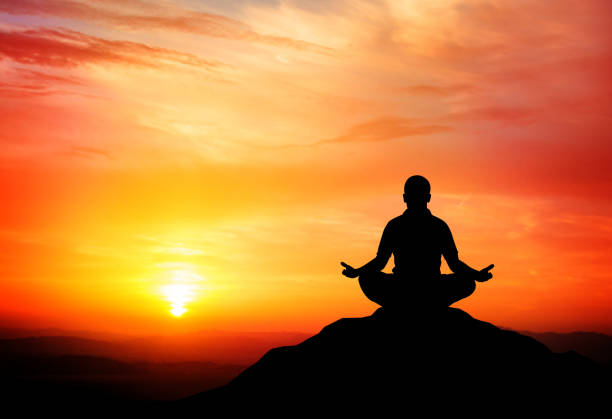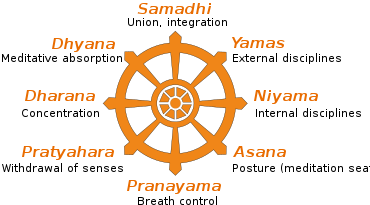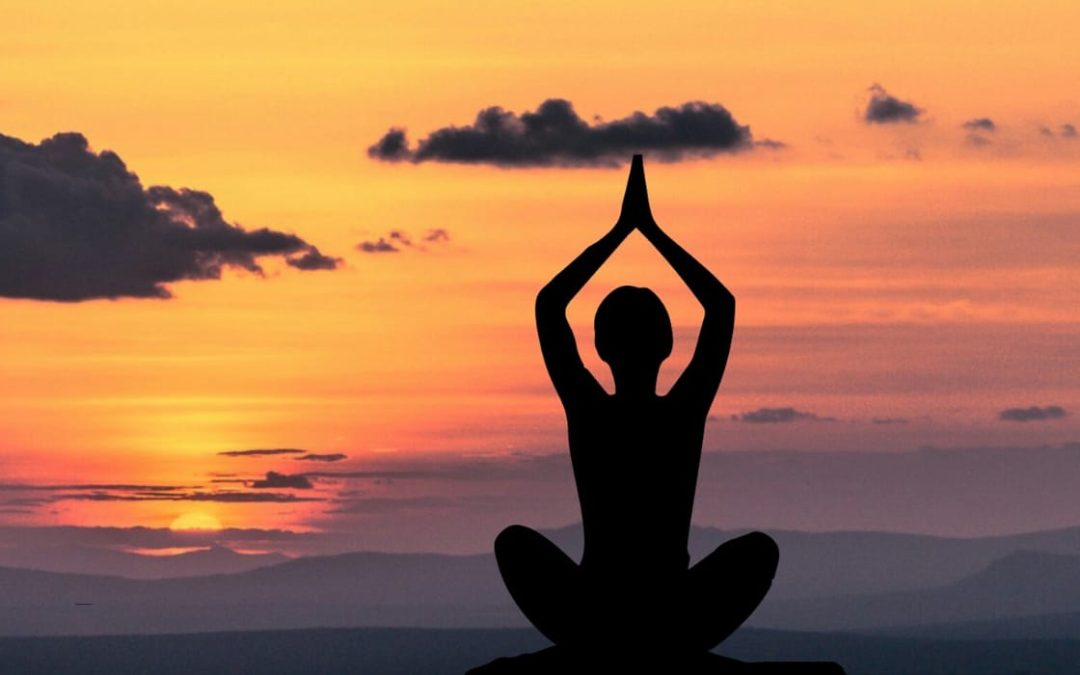
by Tirtha Acharya | Feb 10, 2024 | Yoga
Loving and kindness meditation
Loving and kindness meditation (LKM) is also known as “Metta Bhawana”. This is the first of the Four Brahma (Universal consciousness) Vihara practices taught by Buddha to cultivate good feelings and emotions and eradicate negativity. The Four Brahma Vihara the four celestial dwellings or the four immeasurables) are:
- Metta (loving-kindness)
- Karuna (compassion)
- Mudita (appreciative joy)
- Uppekha (equanimity)
Metta (Sanskrit- Maitreya) is also a Hindu practice as well that develops goodwill and global friendliness towards oneself and others. LKM aims to develop loving-kindness towards oneself and others in a ranked method to comprise all living beings ultimately, both visible and invisible, across the universe. Metta is also interpreted as “universal friendliness” to accentuate the objective nature of the affection generated, without expectation of return or free from any desire.
Some guidance on how to practice LKM.
Posture is all important when learning how to meditate. The most important thing is to be comfortable. Sitting with a straight back in a chair or on the floor is usually advised. When you’ve decided on your posture, do a quick scan of your body to detect areas of tension, such as tight shoulders. Take a few deep breaths and relax. Scan your body again to ensure you’re relaxed but alert.
Loving-kindness meditation- Technique 1
- Sit down in a comfortable pose. Fill your body with positive emotions and goodwill.
- Steadily concentrate on words, “May I be well, happy and peaceful”, as you experience the comforting warmth of kindness enveloping your body.
- Convey to your friend these emotions- “May you be well, content, and at peace. “May you be well, content, and at ease.
- Have a natural breath as this vibration connects you, heart to heart. “May I be good, content, and at peace”. May you be good, content, and at peace”. While mentally repeating these words for two minutes, feel yourself covered in the warmth and brightness of loving-kindness.
- Feel the bathing in the in peace and warmth of meditation that
- The light is bathing you in the warmth and peace of loving-kindness that your surrounds are radiated outwards by you.
- Encompassing all beings in the cosmos, from the tiniest insect to the biggest beast- see you and your companion are beaming love-kindness light into the infinite horizon. May we all be good, content, and peaceful. May everyone, wherever, live happily and in harmony.
- Recite this mentally for about three minutes in natural and conscious breath.
- After this, savor the sensations of warmth and expansion throughout your body. Acknowledge the emotions that emanate from your core and spread throughout the cosmom. Also the kindness that is present everywhere in your heart.
- Mentally recite for about 1.5 minutes- “May we be good, happy and at peace. May everyone and everything be well, joyful, and peaceful.
- Focus on your body and pay attention to your sensations and feelings as you continue to feel the warmth of loving-kindness.
- Take note of “WHAT” is watching your body and become conscious of that awareness- a calm, still aspect of yourself that observes everythin without passing judgement. Breath in a natural way.
- Finally gradually open your eyes.
Loving-kindness meditation- Technique 2
According to legend, the Buddha imparted the advantages of Metta meditation to monks who were struggling to focus while meditating in the forest due to disruptions purportedly created by earth devas and tree spirit. (Buddharakkhita, 2013). It helped people to conquer their fear while meditating by alone in the jungle, vulnerable to several threats.
For instance, most of us know of how being scared or nervous might increase your risk of injury when you travel alone a long way from home. When targeting a victim, those with malicious intent search for signs of vulnerability.
May I/ you be well, strong, content, light, calm, and safe.
Close your eyes and keep your back straight while you concentrate on the heart. If it would help, you can also put your hand there.
First repeat your selected phrases three times to yourself, sending loving-kindness. As an illustration, “May I be strong, safe, and healthy”.
Next, choose a person you genuinely care about (not your spouse or a love partner), a regular observer who is impartial, and a person you are currently struggling with.
Suppose that the four of you are seated in a circle. Repeat the phrase you have selected three times to your circle, keeping them all in the mind.
“May you be robust, safe, and well.” Next, visualize the loving-kindness expanding beyond your immediate circle to include your area, your community, your country, and all living things on Earth.
“May all the beings on the planet Earth be healthy, safe, and strong,” repeat mentally three times. Next visualize the following: “May all beings throughout all time and space be healthy, safe, and strong.” This loving-kindness should then be imagined flowing from the earth into space and to all life-forms in the cosmos.
Return your focus to your breathing and your environment gradually, and then open your eyes.
Benefits of Loving-Kindness Meditation
- It is a mystic blueprint for a longer life with less agony, better happiness, improved relationships, and stronger springiness.
- It augments mental and emotional well-being
- Loving-kindness triumphs over hostility.
- By compassion practice in this meditation, one defeats cruelty.
- Practice of appreciative joy disables jealousy and envy.
There are eleven main benefits as told by Buddha:
- You have a good sleep.
- You wake up feeling rejuvenated.
- You don’t experience nightmares.
- You are viewed with fondness by other.
- Pet and animals think highly of you.
- Angelic creatures guard you.
- You won’t sustain any injuries from poison, fire, or weapons.
- You have quick focus and concentration
- Your complexion is quite radiant or bright.
- You’ll pass away calmly, anxiety or distress.
- In the event that you are not enlightened, your reincarnation will be happy.
Benefits of LKM according to the latest scientific research.
- Lessened self-criticism, soothes our inner critic, and makes us more self-accepting (Shahar et al., 2015). A 49-day of LKM followed in lessening in self-harming impulses in person with suicidal tendencies and boundary personality qualities (Fredrickson et al., 2008).
- Enhanced wellbeing, rises vagal tone, a physiological indicator of subjective wellbeing that raises satisfaction in life and its quality the quality.
- Decreased aging of cells (Le Nguyen at al., 2019)
- Reduced pain- patients with chronic back pain (Happened in- Carson et al., 2005) and migraine (Happened in- Tonelli & Wachholtz, 2014) disclosed that after practicing loving-kindness meditation for a short periods, they experienced a diminution in pain symptoms and were able to go bout their daily lives.
- Grander resilience: This meditation was found to lesion trauma symptoms and flashbacks in the study of individuals with chronic post-traumatic stress disorder (Kearney et al., 2013). Studies that served as controls revealed that groups that used scripts for loving-kindness meditation during their sessions were able to get back to work earlier than those who got other training. (Seppala et al., 2014). It strengthens healthcare personnel’ resilience and helps them avoid burnout. (Seppala et al., 2014).
- Better relationships: According to Hutcherson at al. (2008), it leads to better social ties at work, more empathy for strangers, and more stability in social interactions overall (Don et al., 2022).
- Better mental health: Although research on LKm’s effects on major mental health disorders is still in its early stages, preliminary results have shown that patients with depression and bipolar (Johnson et at., 2011) and schizophrenia (Hofmann et al., 2015) experience fewer delusions and hallucinations.
For more blogs visit on our Nepal Yoga Home blog section.

by Tirtha Acharya | Feb 6, 2024 | Yoga
Ashtanga Yoga: Eight Organs of Yoga
Eight organs of Yoga: Yoga has eight organs according to Patanjali Yoga Sutra. The Patanjali Yoga Philosophy states the following organs:
- Yama: There are five Yamas is social observences. They are
- Ahimsa (Non-violence): There are three types of violence- physical, mental, and verbal violence. If you kill or harm anyone physically, that is physical violence. Harming somebody by speech is verbal violence. Having wrong intentions or negativity for others is mental violence. Abstaining from this violence is the practice of Ahimsa.
- Satya (Truthfulness): What you have spoken fulfill it, i.e. your words should be followed by your actions. Speak what is true. This is about honesty to the self as well.
- Asteya (Non-stealing): This has a depth concept. Even if you use someone’s product without permission comes under stealing. Having greed for someone’s property is also a subtle form of stealing. Seizing someone’s right is stealing. Abstaining from all these stealing is the practice of Asteya.
- Aparigraha (Non-possession): Accumulating excessive worldly materials more than your need blocks you in your spiritual progress. Your mind will get attached to worldly things and you will be busy on these mundane things.
- Brahmacharya: The term ‘Brahma’ means God and ‘charya’ means dwelling. Thus dwelling in God is brahmacharya. A question arises- how to dwell in god? Being mentally connected to the god or positive attributes is known as dwelling on God.
Abstaining from sexual activities and sexual thoughts is also said to be Brahmacharya. However, this is possible only when you transform sexual energy into spiritual energy.
- Niyama: There are five Niyamas i.e. moral observances. They are
- Shauch (purity): There are two types of purity- internal purity and external purity. Internal purity refers to mental purity i.e. free from the negativity in the mind. External purity refers to bodily and surrounding cleanliness.
- Santosh (Contentment): Having satisfaction with what you have in life is contentment.
- Tapaha: Making a hundred percent effort to achieve your spiritual awakenment and self-development is Tapaha.
- Swadhyaya (Study of self): The study of scriptures which helps to realize the self and introspection (review, analysis, and survey of self) is known as Swadhyaya.
- Ishwar Pranidhana (Dedication to God): It is devotion or surrender to the ultimate reality of existence. It is about the faith of universal law.
- Asana: There are 84,00,000 asana according to Hatha Yoga. They are the physical postures. Static and comfortable position of the body is known as asana.
- Pranayama: It is a breathing practice as an instrument of governing prana (vital life force energy). Pranayama is connected with breath or life force. When breath becomes silent, pranayama occurs. When the movement of breath is no more, pranayama happens.
- Pratyahara: Control over your sense organs is pratyahara. Five sense organs keep wanting their food. For example- eyes want to see the views just for entertainment which is of no use for self-progress. Skin just wants sensual pleasure. The tongue wants delicious taste without caring whether the food is healthy or unhealthy. Ears want to listen to various things. The nose wants to smell an odor. These sense organs do not care about whether the things they are longing for are healthy or not. So it’s you who needs to get mastery over them. Pratyahra is also defined as the withdrawal of the senses.
- Dharana: This is the sixth organ of yoga which refers to concentration. The binding of consciousness to a certain point, place, thing, or idea is known as Dharana. “Collection or concentration of the mind” or “the act of holding, bearing, wearing, supporting, maintaining, retaining, keeping back of awareness” are some translations of Dhāraṇā. Dharana is a technique that relaxes the mind. It helps the mind focus attention by removing it from events that cause difficulties. Since yoga calls for concentration on the body, the breath, or even a mantra, it can aid someone in learning the art of Dharana. By engaging in Dharana practice, we can become aware of our mental processes and the thoughts that interrupt us, which eventually results in longer intervals between them over time.
- Dhyana (Meditation): Dhyana is the seventh limb of yoga. When the duration of Dharana increases over three minutes, it becomes Dhyana. In Sanskrit, Dhyana is composed of two words ‘dhi’- which means mind or consciousness, and ‘yana’- which means flowing or moving. Thus, dhyana can be defined as a constant flow of consciousness or mindfulness. Here flow is directed towards the meditation process. So, it is a nonstop flow. The condition of dhyana is characterized by continuity and steadiness, just as the word flow itself does. The individual loses his sense of touch as he becomes engrossed in the bond he develops with the meditation object.
- Samadhi: Samadhi is the ultimate and eighth stage of yoga. The term is derived from Sanskrit roots; ‘sam’ means ” organized “, “together” or ” entirely,” meaning “toward” and ‘dhe’, meaning “put.” Direct translations differ, and analyses stretch from “bliss” to “liberation” or “enlightenment.” It is the highest point of spiritual and intellectual activity. It is also a prerequisite to release samsara (no more cycle of birth and death). In yoga, the state of Samadhi is said to be the union of the individual and universal consciousness. After completing the initial stages of Patanjali’s eightfold path, the practitioner can attain this delightful state of competitive meditative absorption. Samadhi has great spiritual significance since it represents the highest level of union with the Divine and includes self-realization.
Since the final three stages- Dharana, Dhyana, and Samadhi- are said to be intricately connected, they are generally referred to as Samyama (integration). Therefore, it is believed that concentration techniques are the way to genuinely contemplative states, which eventually result in samadhi. According to this definition, meditation is a condition of total absorption rather than a thinking or evaluation exercise.
Therefore, it is believed that concentration techniques are the way to genuinely contemplative states, which eventually result in Samadhi. According to this definition, meditation is a condition of total absorption rather than a thinking or evaluating exercise. Samadhi is described as a pleasant, serene mental state in which the practitioner loses the ability to distinguish between the act of meditation and any other sense of self. Upon liberating the self from ego and delusion of separation, Samadhi remains unaffected by sentiments like longing or rage. By connecting practitioners to their actual Self as one with universal consciousness, Samadhi serves this purpose.
For more blogs visit on our Nepal Yoga Home blog section.

by Tirtha Acharya | Jan 29, 2024 | Yoga
Yogic Breathing for trauma management | Role Of Pranayama for Inner Peace
Yogic Breathing (Pranayama) is very helpful for trauma management, mental tranquility, and spiritual development. Here we are going to discuss the pranayama mentioned in Patanjali Yoga Sutra (Yoga Philosophy of Patanjali). This will release all the negative emotions including trauma, fear, hatred, stress, anxiety, depression, etc. This will prepare you to get victory over your mind and improve your spiritual practices.
Lets go through those fundamental types of breathing:
There are four types of pranayama mentioned in Yoga philosophy of Patanajali inchapter 2 verse number 50 and 51.
बाह्याभ्यन्तरस्तम्भवृत्तिर्देशकालसंख्याभिः परिदृष्टो दीर्घसूक्ष्मः ||2.50|| बाह्याभ्यन्तरविषयाक्षेपी चतुर्थः ||2.51||
The four types of Pranayama:
- बाह्यवृत्ति प्राणायाम (Bahyavriti Pranayama) i.e. Breath out and retention
- आभ्यन्तर वृत्ति प्राणायाम (Aabhyantatavriti Pranayama) i.e. Breath-in and retention
- स्तम्भवृत्ति प्राणायाम (Stambhavriti Pranayama) i.e. Half Breath-in and retention, Half Breath out and retention.
- बाह्याभ्यन्तर विषयाक्षेपी। (Bahyabhyantara Vishayakshipi Pranayama) i.e. Breath retention after previous retention (However teaching methods varies according to teachers)
Before learning these breathing techniques, you need to learn the proper way to breathe.
We generally do short breath. Now we have to practice long breaths.
Technique for long and deep breaths:
- Sit down in a comfortable pose with your back and torso straight. Keep your eyes closed. Concentrate on your abdomen (2 inches below your navel).
- Take a deep exhalation from your abdomen pushing it inwards. Feel the movement of breath from the abdomen to the nostrils.
- After breathing out, there can be a short natural pause for 1 second or more. After Pause of breath inhale long through your nostrils and feel the movement of breath from nostrils to abdomen.
- After breath-in, there can be a natural pause and one cycle is over. In this way repeat for 5 to 10 minutes.
बाह्यवृत्ति प्राणायाम (Bahyavriti Pranayama) i.e. Breath out and retention
Technique:
- Sit down in a comfortable with your back and neck straight. Keep your eyes closed.
- Take a long breath out as long as you can. And retain the breath up to your comfortable moment.
- Inhale long and exhale long. After exhalation, again retain the breath up to your comfortable stage.
- Repeat this process for 5 to 10 minutes.
Note: You can also engage Moola bandha (Root lock), Uddyana Bandha (abdominal lock) and Jalandhar Bandha (throat lock), as well if you know.
आभ्यन्तर वृत्ति प्राणायाम (Aabhyantatavriti Pranayama) i.e. Breath-in and retention
Technique
- Sit down in a comfortable with your back and neck straight. Keep your eyes closed.
- Take a long breath in as long as you can. And retain the breath up to your comfortable moment.
- Exhale long and inhale long. After inhalation, again retain the breath up to your comfortable stage.
- Repeat this process for 5 to 10 minutes.
Note: You can also engage Moola bandha (Root lock), and Jalandhar Bandha (throat lock), as well if you know.
- स्तम्भवृत्ति प्राणायाम (Stambhavriti Pranayama) i.e. Half Breath-in and retention, Half Breath out and retention.
Technique- A
- Sit down in a comfortable with your back and neck straight. Keep your eyes closed.
- Take a long breath in as long as you can. And breathe out half of the duration that you could do fullest extent. And retain the breath up to your comfort stage and finally breathe out completely. In this way continue for 5 to 10 minutes.
Technique- B
- Sit down in a comfortable with your back and neck straight. Keep your eyes closed.
- Take a long breath out as long as you can. And breathe in half of the duration that you could do fullest extent. And retain the breath up to your comfortable stage and finally breathe in completely. In this way continue for 5 to 10 minutes.
- बाह्याभ्यन्तर विषयाक्षेपी। (Bahyabhyantara Vishayakshipi Pranayama) i.e. Breath retention after previous retention (However teaching methods varies according to teachers)
Technique-1:
- Sit down in a comfortable with your back and neck straight. Keep your eyes closed.
- Concentrate on the base of your nose, just above your upper lip. Or you can concentrate on the nostrils’ passage.
- Try to watch your natural inhalation and exhalation. If you cannot notice your automatic or natural breath, you can take a long breath in and out for 2-3 times. This will help you to recognize your breath. And then you can work with natural and spontaneous breath again. Do it for at least 10 minutes. You can do longer as well up to one hour in the morning and one hour in the evening.
This practice can be done at any time whenever you are free. This practice is very helpful to develop mindfulness and release all types of mental defilements.
The technique-2 can be practice should be practiced only with the teacher. If not practiced in the right way, it may create negative impacts.
Technique-2:
- Sit down in a comfortable with back and neck straight. Keep your eyes close.
- Take a long breath out as long as you can and retain the breath. When you feel that you cannot retain the breath any more try to breath out again. In this way repeat few times.
- After that take a long breath in and retain the breath. When you feel you cannot retain the breath, then try breath in again. Repeat it for 5 to 10 minutes.
Benefits:
- Pranayama (yogic breathing) increases your lung capacity and helps you to flow a sufficient amount of oxygen to your brain and body.
- Pranayama cleanses your body from a subtler and deeper level. When the body is cleaned with pranayama, the specks of dirt or impurities (known as diseases) will be automatically washed. Thus this is the perfect way of attaining health.
- It purifies your mind and strengthens the capacity of the mind.
- It increases focus, awareness, understanding, and creativity.
- When your body and mind are purified you will start enjoying bliss and perfect harmony in life.
Contraindications:
- Never practice pranayama if your abdomen is not empty. So the morning time before breakfast is the best. Or you can practice after a 5-hour gap of your meal. However, breath observation can be done at any time.
- You can do pranayama only with an expert master especially if you have problems like high blood pressure and heart-related diseases.
- Practice pranayama only in a clean and airy environment.
For more blogs visit on our Nepal Yoga Home blog section.

by Tirtha Acharya | Jan 23, 2024 | Yoga
Struggling to Tone Your Arms? These 4 Essential Exercises Will Help You Achieve It
Are you trying to tone your arms and need some help to achieve this? These yoga poses are fantastic exercises and provide many physical and health benefits. They also provide spiritual and mental benefits to those who practice consistently.
Here are some additional things you might experience when you maintain a regular practice:
- An increase in your metabolism – you will burn calories and start building lean muscle.
- Better physical performance – improving strength in your arms will make daily physical activities easier.
- Strengthening of your bones – some resistance exercises involved in toning your arms can lead to stronger bones, reducing the risk of osteoporosis as you age.
- Improved posture – strengthening your shoulders and arms can help to improve your posture by relieving strain on your neck and lower back.
- Increased circulation throughout your body.
- Calming of the mind and relaxation of the body.
Equipment you’ll need for these exercises:
- A yoga mat
- Water to remain hydrated
- Wear comfortable, breathable clothing
Once you have everything you need, find the best time of day to practice these yoga poses, as your body and mind might respond differently at different times. Feel free to do the following exercises indoors or outdoors, but try to avoid extreme conditions such as very hot and humid or very cold conditions. Where and whenever you choose to do your exercises, make sure you are comfortable and fully hydrated.
Join us in these four essential, easy-to-follow yoga poses that will help you tone your arms.
- Plank Pose (Phalakasana)
Plank pose will not only tone your arms it will also help you to build strength in your wrists, forearms, biceps, and triceps. This pose also helps increase stability in your shoulders.
Easy-to-follow steps:
- Start in a push-up position with your arms extended and your hands lined up with your shoulders.
- Engage your core and leg muscles. Ensure your body is straight and your midsection is held off the ground.
- Hold the pose for 30 seconds or until you lose your form.
- If you want to increase the heat, you can get into full plank from Chaturanga Dandasana by pushing up from your hands.
Top tip: Hold the plank and focus on your breathing while you imagine pushing your body up to the sky.
- Chaturanga Dandasana (Four-Limbed Staff Pose)
The four-limbed staff pose is a style of vinyasa yoga. This pose follows from the previous plank pose and is important in helping you to tone your arms.
Easy-to-follow steps:
- Start in a plank pose and bend your elbows to a 90-degree angle, lowering your body towards the ground. Keep your elbows close to your sides.
- Your body should be 3 to 4 inches above the ground.
- Engage your core and keep your body in a straight line.
- Hold this pose for 3 to 4 breaths or until you lose your form.
Top tip: Use your arm strength in this pose by engaging your triceps and biceps and tucking your elbows as close to your ribs as possible. If you need a little help, you can roll up a thick blanket and place it under your chest parallel to your spine to help you maintain your form.
- Trikonasana (Triangle Pose)
This pose is ideal if you want to tone your arms, especially if you can flex your muscles while in position. Additionally, it helps to strengthen and stretch the shoulders.
Easy-to-follow steps:
- Start in a standing position with your hands at your sides. Make sure that you are balanced.
- Spread your legs in line with your shoulders, maintaining your center of balance. Your feet should now be shoulder distance apart.
- Inhale and simultaneously lift your arms with your palms facing the floor until you reach shoulder height.
- Exhale and at the same time, turn your torso to the left and bend your waist, bringing your right arm down to your left ankle. The palm of your right hand should be placed on the outside of your left ankle.
- Your left arm should now be extended upwards. Remember to keep your legs and arms straight, there should be no bending of the knees or elbows.
- Turn your head to the left and look up at the fingertips of your right hand.
- Inhale and return to your original standing position with your arms outstretched.
- Repeat the steps to the right side of your body.
- Feel free to repeat this exercise 2 to 3 times, noting that one repetition includes both the left and right sides.
Top tip: Execute this pose slowly and be mindful of your balance and positioning. Remember your breathwork.
- Adho Mukha Svanasana (Downward-Facing Dog Pose)
Downward-facing dog will spread your body weight between your arms and legs while also helping to rotate your shoulders. As a result, it will tone your arms as you are using them as a major point of support.
Easy-to-follow steps:
- Start on all fours, on your knees, your back straight, and your palms placed flat on your yoga mat. You should look like a makeshift table.
- Make sure your hands are shoulder-width apart and your legs are hip-width apart.
- Breathe out, slowly lifting your hips toward the ceiling. Your arms and legs should be straight, and your body should be in an upside-down V-shape.
- Push your hands into the ground as if you are pushing it away. Be mindful not to over-exert yourself.
- Open your shoulder blades and lengthen your neck by bringing your ears to touch your inner arms.
- Exhale and bend your knees, returning to your original starting position.
Top tip: Warm up your legs and arms before attempting this exercise.
Key points to remember that will help you achieve your goal:
Warm up before doing any exercise.
- Be patient with yourself. Remember, results take time and effort.
- Quality over quantity, focus on your form.
- Consistency is key. Building a routine that fits in with your lifestyle is essential.
- Stay hydrated. Water regulates your body temperature, lubricates joints, and protects your muscles and organs.
- Listen to your body. Don’t overdo it or push yourself too hard.
- Always be mindful of your breathing.
Exercise doesn’t need to be a lengthy or laborious task. Spending just 20 minutes a day doing these four poses will tone your arms and deepen your practice in a physical, mental, and spiritual way.

by Tirtha Acharya | Nov 30, 2023 | Yoga
Meditation Techniques to Transform Your Life
Cakra Meditation with Mantra – We chant and meditate on the resonance created by the chanting of sanskrit bija mantras that helps to bring positive energy in the body and mind.
Cakra Meditation and visualization – Each Cakra has its element. We connect with those elements by the use of visualization technique.
Cakra Meditation with breathing – Each Cakra is connected with a color. We connect cakra with the colors and breathing technique to activate energy channels.
Cakra Balancing technique – Each person has week and powerful energies by birth. We bring the harmony and balance in each cakra through breathing technique and visualization technique.
Yoga nindra – Yoga nindra is powerful technique that improves awareness, alertness and intuition.
Trataka – Candle light meditation is good for eyes, sleep and concentration. It is a very good practice for beginner.
Meditation wt mudra – Different powerful mudras like sambhavi, aghochori helps to enhance the meditation. We use many mudras along with the meditation practice.
Meditation with mantra – We use mantra chanting as a means of meditation. It is very good technique to balance our emotions.
Mantras like Ganesh Mantra, Mahamrityunjaya Mantra, Gayatri Mantra, Omkara Mantra etc.
Visualization Meditation – Om Kara meditation – We use the Om kara chanting meditation with the visualization technique. We also can combine the trataka method in this technique for better visualization.
Relaxive visualization Meditation – Visualization during deep relaxation can help to relax more effectively.
Ajapa japa Meditation – We combine different stages of chanting to make meditation more powerful in this technique. Many mantras can be used like Omkara.
Aana paana Breathe awareness Meditation – it is the simplest but yet effective technique to begin with. Breathe is an easy way to focus during the meditation.
Sohum Meditation – We use the sohum mantra along with the breathe observation practise. This helps to soothe our mind and mantra has also very calming effect on it.
Pet – Pranic Enersization technique is a meditation practised with different mudras and body scanning technique to bring a harmony and balance in an energy body.
Cyclic Meditation – In cyclic meditation we use series of yoga postures as a part of meditation.
Msrt – Mind sound resonance technique is a combination of mantra chanting on meditation. It is practiced more systematically connecting with the frequencies of the mantras in this technique.
Recalling Meditation – Recalling meditation is a technique of observation of action and its influence. It helps to calm down our overthinking mind.
Kirtan kriya Meditation – We combine the mudras with the Snatnam mantra which helps to awaken our energy and soothe the mind.
Five body awareness Meditation – In this meditation we practice the concept of five sheaths of body in yoga. It begins with body awareness and then dissolving in the essence of silence.
For more blogs visit on our Nepal Yoga Home blog section.

by Tirtha Acharya | Nov 28, 2023 | Yoga
Here are the list of precaution for practicing yoga asanas:
1) Śauca (cleanliness) – Cleanliness or purity is an important requirement for Yoga practice. It embraces the cleanliness of the environment, body, and mind.
2) Asanas and pranayama should be practiced on an empty stomach. If you feel hungry or weak, consume a little bit of fruit or juice or some liquid like a small amount of honey in lukewarm water, etc.
3) Emptying the bladder and bowels before starting Yogic practices gives wonderful benefits.
4) Practice periods should commence with Aum chanting and a prayer or an invocation as it generates a conducive setting to calm down the mind.
5) Yogic practices should be carried out slowly, in a relaxed peaceful mode, with mindfulness of the body, breath, and activities.
6) A joint exercise, subtle exercise, warm up or loosening exercise, and stretches before yoga- asanas are obligatory to avoid damage.
7) Slowly performing asana will allow you to progress to more difficult asana with time.
8) Satvik food helps to reach the depth of yoga. Avoid non-veg food, eggs, junk food, canned food, processed food, etc.
9) Before beginning your yoga practice, remain hydrated.
10) Dress in comfortable and supportive clothes. To allow for ease of body movement, cotton garments or other light and comfy clothes should be used.
11) Yoga should be practiced in a place with good ventilation and a gentle breeze.
12) When practicing yoga asana, use a mat with a good grip.
13) While performing yoga poses, be mindful of your breathing.
14) After yoga practice, use relaxation techniques like savasana to wind down.
15) Except when specially instructed to do so during the practice, do not hold your breath
16) Unless specifically taught differently, breathing should always be done through the nose.
17) Avoid overly tightening the body or jerking it violently.
18) Perform the yoga-asana to the best of your ability. Good results take time to achieve, so perseverance and frequent practice are crucial.
19) Some of the yoga poses have restrictions and contra-indications, and these contra-indications should constantly be kept in mind.
20) An effective yoga practice should conclude with savasana and finally meditation, prolonged silence or Sankalpa or Śānti pāṭha, etc.
21) The Yamas and Niyamas are yoga’s ethical principles and practices that are outlined in the first two limbs of Patanjali’s eightfold path. Together, they provide a moral code of behavior for the spiritual seeker.
The Yamas or restraints include Ahiṃsā (Nonviolence); Satya (Truthfulness); Asteya (Not stealing); Brahmacharya (Marital fidelity, sexual restraint); Aparigraha ( Non-avarice, non-possessiveness). Other attributes such as Patience, forgiveness, Fortitude, perseverance with the aim to reach the goal, Compassion, Non-hypocrisy, sincerity, Measured diet, etc. are also to be implemented.
The niyamas are behaviors or rituals to follow. They include-
- Śauca (Wholesomeness, Pureness of mind, speech, and body);
- Santoṣa (Contentment, satisfaction, acceptance of others and of one’s circumstances as they are, optimism for self)
- Tapah (Austerity, self-discipline- insistent meditation, persistence)
- Svādhyāya (Study of self, self-reflection, introspection of own feelings, speeches, and activities)
- Īśvarapraṇidhāna- Observation of the Ishvara (God/ Absolute Being, highest consciousness).
Some important tips to be followed while practicing an asana (third limb of yoga):
- Do not do asana without vinyasa. Here Vinyasa means careful linkage of breath and body. This past is very essential.
- Always listen to your body while doing an asana. Try to experience the sensation of the body during the pose (asana)
iii. Whenever asana is intense, practice ujjyai breath, or long breath. Continue to observe your breath as well.
- Try to feel the inner energy vibrations during the asana.
- Feel the organs that are being engaged or stretched.
Some important tips to be followed while practicing a Pranayama (fourth limb of yoga):
- Do not do pranayama very forcefully.
- Duration of internal breath retention and external breath retention should be as long as you feel comfortable. Never try these activities beyond the limit of comfort.
iii. Empty abdomen is very important.
- If you are suffering from High blood pressure or heart-related problems take special precautions from the yoga expert.
Avoid
- Yoga should not be practiced when you are sick, exhausted, in a rush, or under intense stress.
- In case of recovery from surgery, fracture, or sprains consultation with professionals.
iii. Regular yoga practice, especially intense and inverted asanas, should be avoided by women during their periods. Instead, you could practice gentle and easy asanas, pranayama, and relaxation techniques.
- Avoid doing yoga right after eating. Wait until 2 to 3 hours following a substantial meal. After doing yoga, wait 30 minutes before taking a shower, drinking water, or eating.
- Asana can be avoided in confrontational and thrilling weather like too cold or humid, too hot, etc.
- Before yoga-asana practice, check with health professionals if you are pregnant, have serious diseases, have any injuries, etc.
For more blogs visit on our Nepal Yoga Home blog section.






